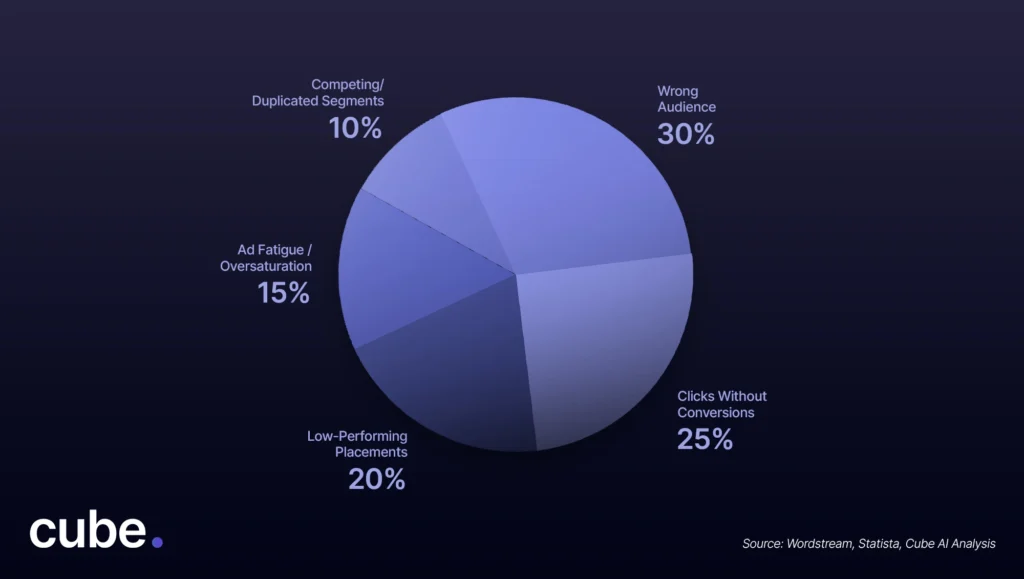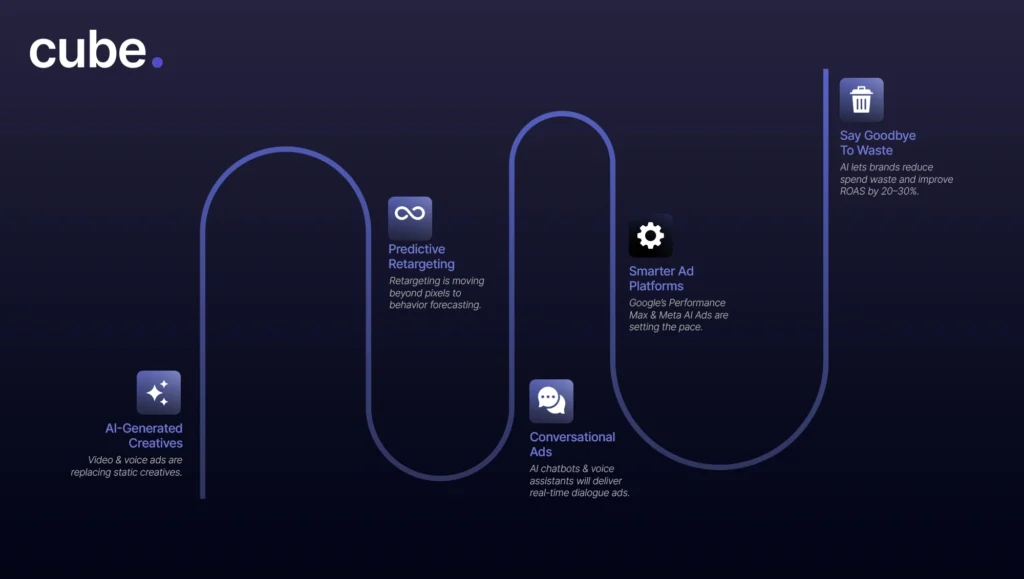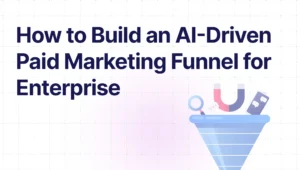Are your ad budgets rising but performance falling? For growth-stage startups and enterprise brands alike, the pressure to justify every marketing dollar is growing fast.
Here’s the challenge: Despite sophisticated tools and cross-channel efforts, you are probably still struggling with wasted spend; clicks that don’t convert, audiences that aren’t searching for your products, and campaigns that rely more on guesswork than insight.
This is where Cube AI comes into play. We help businesses cut 20–30% of ad spend waste by integrating AI-driven ad optimization systems that predict behavior, automate real-time decisions, and increase ROAS, all while lightening the load on internal teams.
Let’s unpack what causes ad spend waste and how AI streamlines budget allocation, bidding, targeting, and creative testing.
Understanding Ad Spend Waste

Wasted ad spending is the portion of your ad budget that doesn’t help your business, including:
- Showing ads to the wrong audience
- Views that don’t result in clicks
- Clicks that don’t result in conversions
- Duplicated audience segments, competing with each other
- Inappropriate placements at the wrong time
Let’s say you created a Google Ads campaign using broad-match keywords. The campaign is live, and the ads are getting hundreds of thousands of impressions. But then, those impressions result in barely a few clicks.
Without conversion data, how would you know what to improve – targeting, creative, or budget? And without that insight, do you just keep spending on audiences that aren’t delivering results?
According to Wordstream, inefficient bidding and targeting account for over 25% of wasted spend in the average Google Ads account. Statista puts the global cost of ad fraud and digital inefficiency at over $120 billion annually.
If you are a startup (or even an enterprise), can you afford to be part of this $120 billion wasted ad spend? Wasted spending is more than just lost money. It is a missed opportunity. Every misallocated dollar that is wasted could be going to acquiring high-value customers and gaining valuable insights into their spending patterns.
Where Traditional Optimization Falls Short
Your team might be running A/B tests, adjusting bids, and monitoring performance. But even the most skilled marketers can’t keep up with today’s digital complexity.
Here’s why:
- A/B tests take too long to reach conclusions
- Manual changes are reactive, not proactive
- Data overload makes real-time decision-making impossible
- Bids and budgets are usually adjusted weekly, which is too slow in a live auction environment
You’re constantly playing catch-up, and that lag time translates to lost revenue.
How AI Transforms Ad Spend Optimization
AI doesn’t guess. It learns and adapts faster than any team can. Here’s how Cube A can improve your ad spend performance:
- Predictive Targeting: AI models analyze past behavior and real-time user signals to show ads to people who are most likely to convert.
- Real-Time Bid Optimization: AI adjusts bids in milliseconds, considering location, device, time of day, and intent. That means no more overbidding or underbidding.
- Automated Creative Testing: AI can test hundreds of headline/image/CTA combinations and instantly pick the best performers, boosting both engagement and ROI.
In a nutshell, AI doesn’t eliminate wasted time, effort, or budget, but it amplifies and maximizes every high-value touchpoint.
Use Cases: AI Cutting Waste Across Channels
Let’s see how AI enhances performance across different platforms:
Google Ads
AI-powered bidding models leverage historical account data and real-time user signals to predict which clicks will most likely convert. Smart Bidding models can improve conversion rate while reducing cost-per-click (CPC) significantly.
Meta (Facebook/Instagram) Ads
Meta’s AI tools automatically create testing variations to match user preferences and optimize audience targeting in real-time, increasing personalization and reducing wasted ad spend.
Programmatic Display
AI is able to identify high-value audiences based on intent, context, and behavior. This means your display ads are being shown in the right place, at the right time, while reducing ad fraud and unqualified visitors.
The ROI of AI Ad Optimization
AI doesn’t just reduce waste; it enhances the total performance that the team sees. Here’s how:
- Better targeting, stronger conversion, and lower CPA
- The fluidity of budget flows allows the money to flow only to what is driving results in real-time
- More accurate decision-making allows the team to scale more quickly without moving into riskier decisions
In our work, we’ve seen firsthand that AI allows smaller marketing teams to accomplish results that were previously only possible by large, specialized teams. The focus is no longer on micromanaging campaigns. Instead, it frees up time for strategic building and discovering, and testing new growth opportunities.
Integrating AI into Your Paid Marketing Stack
Switching to AI ad optimization is not as big of a leap as it seems. Performance Max (Google), Meta Advantage+, and programmatic DSPs via ad networks utilize AI out of the box.
When reviewing AI tools, consider whether:
- Transparency: Do you understand the rationale behind AI decisions?
- Data control: Are you able to manage any data sources utilized and user privacy?
- Ease of integration: Is it viable in your tech stack?
At Cube, we work with brands that prioritize intelligent workflows that integrate directly into campaigns without disrupting existing workflows. It is about upgrading, not completely rebuilding.
Overcoming Hesitations: Is AI Worth the Shift?
Switching to AI-powered work systems can feel overwhelming, potentially leaving you with the impression of a loss of control. However, when AI is implemented accurately, it with function as an effective enhancing assistant rather than a replacement.
Now let’s answer some of your FAQs on integrating AI into your advertisement pipelines:
Will I lose visibility or control?
Not at all. Most AI-powered ad tools offer full transparency and manual override options. You can monitor performance, adjust parameters, and step in at any time. Think of Cube AI as a smart assistant, not a black box.
What if AI doesn’t deliver results right away?
Like any optimization system, Cube AI requires a brief learning period. But over time, it consistently improves performance by identifying patterns, testing faster than humans, and reducing inefficiencies. Short-term dips are normal; long-term gains are where AI shines.
Is it ethical to use AI in advertising?
Yes, when used responsibly. Cube’s AI tools comply with data privacy laws like GDPR and CCPA and are built to avoid discriminatory targeting. As always, ethical advertising depends on how you set your strategy and define your audience.
Will AI replace my marketing team?
No, it’s here to amplify them. Cube AI automates repetitive, time-consuming work (like bid adjustments, A/B testing, and keyword optimizations), so your team can focus on strategy, creativity, and growth.
Does AI require a big budget to be effective?
Not necessarily. Cube AI helps optimize whatever budget you’re already working with. In fact, many brands use it to cut waste and get more value out of modest spend, especially in competitive markets.
How quickly can we implement it?
That depends on your current setup, but with the right tools, you can start seeing results within a few weeks. At Cube, we help you integrate AI into your ad operations with minimal disruption and immediate clarity.
Cube AI is your performance co-pilot. We help you scale, experiment, and optimize without burning out your team!
Measuring Success: Metrics That Prove the Shift Is Working
To see real results from AI ad optimization, you need to track the right metrics. These KPIs highlight improvements in efficiency, performance, and ROI, and help you prove what’s working:
- Ad Spend Efficiency
Track how much of your ad budget leads directly to conversions, not just impressions or clicks. AI helps reduce wasted spend by aligning the budget with high-intent users. - Click-Through Rate (CTR)
A rising CTR indicates your targeting and creative are resonating with the right audience. AI continuously tests and refines messaging to boost engagement where it matters. - Cost Per Acquisition (CPA)
A lower CPA means your ads are reaching high-converting users more efficiently. AI optimizes bids and placements in real time to stretch your budget further. - Ad Frequency Control
AI regulates how often users see your ads, helping you avoid ad fatigue. This keeps engagement rates high and ensures your budget isn’t wasted on oversaturated audiences. - Attribution Accuracy
Smarter attribution models make it easier to connect ad interactions to revenue. With AI, you get a clearer picture of what’s driving results and where to double down.
Be sure to compare these metrics before and after implementing AI. The goal isn’t just to reduce waste, it’s to build smarter campaigns that convert more efficiently, adapt faster, and require far less manual effort. AI doesn’t just cut costs; it improves how your entire ad engine performs.
What’s Next for AI in Paid Marketing?

We’re just really starting to scratch the surface.
- AI-generated video and voice ads are replacing static creatives.
- Hyper-personalized retargeting is moving beyond pixel tracking to predictive behavior.
- Conversational ads through AI chatbots and voice assistants are coming soon.
Google’s Performance Max and Meta’s (formerly Facebook) evolving AI Ads roadmap are clear signals that the future is for marketers who embrace algorithms, not avoid them. Staying competitive means thinking ahead because your competitors already are.
It’s Time to Cut the Waste
Let’s be honest: ad spend waste is not a necessary evil. It’s a solvable problem, and AI ad optimization can help you do better. We do not need to spend less; we need to spend smarter. If your paid media is feeling bloated, reactive, or underachieving, it’s time to rethink your whole approach.
Companies using AI-powered workflows from Cube are seeing cleaner data, higher ROI, and marketing teams that operate with clarity and control.
Ready to cut the waste and take back your budget? Let’s put AI to work for you. Book a demo call with Cube today.


